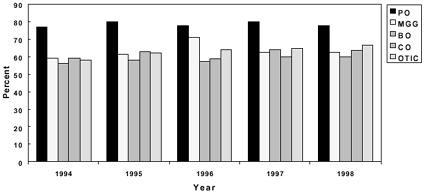 |
|
| Mail
Reviews
Mail reviews are essential to the evaluation of practically every proposal received by the Division of Ocean Sciences (OCE). Each year we request between 6500 and 8000 mail reviews and our community is to be commended for the time and effort expended on each proposal. If every reviewer fulfills their responsibility and devotes an average of 8 hours to each review, then this corresponds to a request each year by OCE that the community expend 26 to 32 person years of effort (assuming 2000 hours per person year) on this essential process.
Over the past 5 years in OCE's Ocean Sciences Research Section (OSRS), 64% of the requests for proposal reviews were successful, 2% were returned because of real or perceived reviewer conflict, 0.3% were declined, and no responses were received for 34% of the requests. By comparison, the total response rates for OCE, the Directorate for Geosciences, and all of NSF, were 66%, 70% and 71%, respectively.
Figure 1 shows the distribution of reviewer response rate by program within OSRS. As can be seen, the Physical Oceanography Program consistently has a reviewer response rate that is 15-20% higher than the other programs. There is no clear understanding of the reasons for this difference.
The staff of OCE understands the magnitude of the effort required to review the increasingly large number of proposals that we receive each year. But it is an essential component of the careful NSF merit review process that lies at the heart of our mission to identify and support the highest quality basic research. We constantly search for ways to increase the reviewer response rate, and thus reduce the number of review requests that we have to mail out. Few practical ideas have emerged from this search. One suggestion that is frequently heard is to follow the practice of professional journals, and place an advance phone call (or email) to each potential reviewer, provide an overview of the proposal and determine their willingness (or not) to provide a review. Although the good sense of this suggestion is clear, given present staffing levels at NSF, it is simply impractical. The following example establishes this. In 1998 our Marine Geology and Geophysics program (MG&G) sent out 2444 requests for reviews. Almost all of the proposals are received in response to one of our two regular target dates (February 15th and August 15th). The review requests have to be mailed out within approximately one month of each target date. This would require the phone calls or emails (requesting community members to provide reviews) to occur within two four week periods (a total of approximately 40 working days). If on average the (extremely) optimistic assumption is made that only two calls or emails are required for each review request, then this would require a total of approximately 4900 phone calls or emails over 40 days, or more than 120 per day (just for the MG&G program). We do not come close to having the staffing levels required to sustain an effort of this magnitude!
While we continue to search for solutions to this seemingly intractable problem, we renew our plea to the community to inform the Program staff as soon as possible if you determine that you are unable to review a proposal. And when you do submit a review, please insure that it is received at NSF in a timely manner. While the receipt of a mail review is welcomed at any time before the final decision is made on a proposal, the value of that review, and its impact on the process, is increased substantially if it is received prior to the panel.
Figure 1. PO=Physical Oceanography, MGG=Marine Geology and Geophysics, BO=Biological Oceanography, CO=Chemical Oceanography, OTIC=Ocean Technology and Interdiscipliary Coordination |
|
